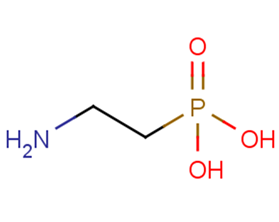
2-Aminoethylphosphonic acid
CAS No. 2041-14-7
2-Aminoethylphosphonic acid( 2-AEP | Ciliatine )
Catalog No. M19574 CAS No. 2041-14-7
Ciliatine belongs to the class of organic compounds known as organic phosphonic acids. Ciliatine has been primarily detected in urine.
Purity : >98% (HPLC)
 COA
COA
 Datasheet
Datasheet
 HNMR
HNMR
 HPLC
HPLC
 MSDS
MSDS
 Handing Instructions
Handing Instructions
| Size | Price / USD | Stock | Quantity |
| 100MG | 35 | In Stock |


|
| 500MG | 82 | In Stock |


|
| 1G | 120 | In Stock |


|
Biological Information
-
Product Name2-Aminoethylphosphonic acid
-
NoteResearch use only, not for human use.
-
Brief DescriptionCiliatine belongs to the class of organic compounds known as organic phosphonic acids. Ciliatine has been primarily detected in urine.
-
DescriptionCiliatine belongs to the class of organic compounds known as organic phosphonic acids. Ciliatine has been primarily detected in urine. Ciliatine participates in a number of enzymatic reactions. In particular ciliatine can be biosynthesized from phosphonic acid. Ciliatine is also a parent compound for other transformation products including but not limited to ceramide 2-(methylamino)ethylphosphonate N-(2-phosphonoethyl)cholamide and CMP-2-aminoethylphosphonate.
-
In Vitro——
-
In Vivo——
-
Synonyms2-AEP | Ciliatine
-
PathwayOthers
-
TargetOther Targets
-
RecptorOthers
-
Research Area——
-
Indication——
Chemical Information
-
CAS Number2041-14-7
-
Formula Weight125.06
-
Molecular FormulaC2H8NO3P
-
Purity>98% (HPLC)
-
SolubilityDMSO:10 mM
-
SMILESNCCP(O)(O)=O
-
Chemical Name——
Shipping & Storage Information
-
Storage(-20℃)
-
ShippingWith Ice Pack
-
Stability≥ 2 years
Reference
1.Trebst A Geike F: [On the biosynthesis of phosphonamino acids. The distribution of radioactivity in aminoethylphosphonic acid following incorporation of position-labelled glucose by Tetrahymena]. Z Naturforsch B. 1967 Sep;22(9):989-91.
molnova catalog



related products
-
4-Chloro-3-(trifluor...
4-Chloro-3-(trifluoromethyl)phenyl isocyanate is a biochemical reagent that can be produced by a series of reactions between o-chlorobenzotrifluoride and acetic anhydride.
-
Orthosphenic acid
Orthosphenic acid is a natural product isolated from M. triflora.
-
H-DL-Gly-OBzl HCl
Compound Fr13877 is a useful organic compound for research related to life sciences.



 Cart
Cart
 sales@molnova.com
sales@molnova.com


